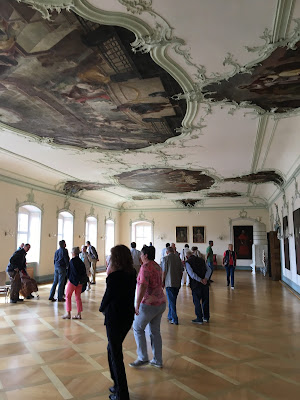When we were looking for a base to camp and explore the Black Forest in summer 2017 I read about this little place. A Baroque Benedictine abbey in a place sharing my name - sounded good - and it was better than we could have believed. Idyllic campsite with stunning view of forest and short walk round the hill to remarkable abbey as centre of the village. How did we ever move on?
 |
The Dukes of Zahringen founded Freiburg and then the monastery of St Peter in 1093 and St Peter became the burial place of the family. There were 4 fires 1238, 1432, 1644 and 1678 so the abbey we see today is completely Baroque. Peter Thumb was the designer 1724-7 . It was dissolved in 1806 and became a field hospital 1813-4 and 1815 in the Napoleonic War.From 1842 to 2006 it was the seminary and since then a spiritual centre for the Archdiocese of Freiburg
|

(
Nave of church of Abbey of St Peter Flickr Jan Zeschky)
|
Abbot Ulrich Burgi 1719-39 was the instigator of the new Church. It has a single aisle of 60 metres in the Vorarlberg minster plan with wall pillars. It has a strong longitudinal feel when you enter because the indirect light and side pillars. The scenes on the ceiling illustrate the life of St Peter healing the sick, vanquishing Simon Magus, healing the lame and the Transfiguration. They are by F.J Spiegler (the master of the ceilings at Zwiefalten).
|
 |
We sat in the monks' choir on seats dating from 1760
while on the guided tour Note the separate choir organ. |
 |
View back down the nave to the entrance to the church and main organ |
 |
High altar in the choir
Then the tour of the Abbey began. A beuatifully restored corridor led up to the famous library. Abbot Burgi had this agreed by the community in 1737 but construction work stopped at his death in 1739 and only began again under Abbot Philipp Jakob Steyrer with the participation of Peter Thumb. By 1752 the library was completed. There was a major renovation in the 1960s and then for the 900 year celebrations in 1992/3 more was done on both the church and the library.
|
The library is a rococo masterpiece. The spirit of the Enlightenment is there on the ceiling : the angel in the centre has an open book with the Father of Light (the Trinity) below as the fountain of wisdom from whom the Fathers of the Old Testament received knowledge. There are 6 Fathers of the Church and 10 learned Benedictines. the underlying idea is that this room has been imbuedd with the wisdom of God here and now. There are 2 globes made by the local monks in the 1780s.
 |
| Library ceiling by Benedict Gambs, 1751. |
 |
| A bit of 18th century atmosphere : Ochsenhausen abbey and 2 Benedictine monks |
 |
| The Festsaal |
Finally we were shown the Festsaal. This is the usual large celebratory room used on occasions with the public and visitors. It includes portraits of Empress Maria Theresa and her husband Emperor Francis, brought back from Vienna by Abbot Steyrer in 1763.
 |
| The Festsaal |
 |
| Ceiling of Festsaal : the supper witrh Simon the Pharisee by Simon Goser 1773. |
 |
| Floor plan : Churtch at topo Library in centre and Festsaal in centre at the bottom. |
 (
(











No comments:
Post a Comment